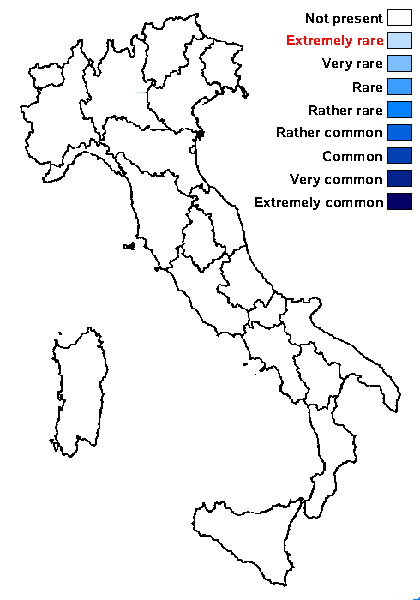Hymenelia carnosula (Arnold) Lutzoni
in Lutzoni & Brodo, Syst. Bot., 20, 3: 250, 1995 . Basionym: Aspicilia carnosula Arnold - Flora, 52: 267, 1869
Synonyms:
Distribution:
Description: Thallus crustose, thinly episubstratic, continuous to finely rimose, whitish to grey, without a distinct prothallus. Apothecia 0.1-0.2 mm across, rounded or irregular, at first immersed in the thallus, then subsessile, with an initially concave, then flat, pink disc, and a rather evident, whitish to pinkish proper margin. Epithecium colourless, K-, N-; hymenium colourless, up to 50 µm high, I+ deep blue; paraphyses simple or sparingly branched, moniliform in upper part, the apical cells slightly swollen; hypothecium colourless. Asci 8-spored, cylindrical-clavate, the outer coat I+ blue, but the inner walls and apical dome K/I-. Ascospores 1-celled, hyaline, globose, 5-6 µm wide. Pycnidia immersed, pale-walled. Conidia short-bacilliform. Photobiont trentepohlioid, the cells 10-18 µm wide. Spot tests: thallus K-, C-, KC-, P-, UV-. Chemistry: without lichen substances.Note: on limestone below or near treeline, in rather shaded-humid situations; distribution poorly known, reported from the Eastern Alps outside the Italian territory. To be looked for in the Italian Alps.
Growth form: Crustose
Substrata: rocks
Photobiont: Trentepohlia
Reproductive strategy: mainly sexual

Predictive model
Herbarium samples
Growth form: Crustose
Substrata: rocks
Photobiont: Trentepohlia
Reproductive strategy: mainly sexual

Predictive model
| Herbarium samples |
 Index Fungorum
Index Fungorum
 GBIF
GBIF

